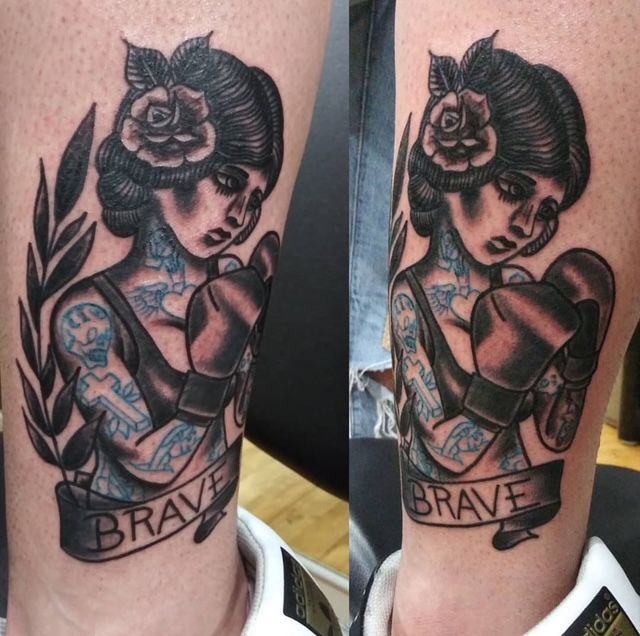Crafting bold, personalized ink that tells your story
About Willy’s Tattoo Artistry
Understanding the Tattooing Process
01
Step 1: Consultation
We begin by discussing your design ideas, placement, and any concerns to ensure your vision is clear and achievable.
02
Step 2: Preparation
Your skin is cleaned and shaved if necessary. I set up sterile equipment and prepare the stencil for precise application.
03
Step 3: Tattooing
Using a tattoo machine, I carefully apply the design, adjusting technique based on your skin and the artwork’s details to ensure quality and comfort.

Pain Levels Vary by Placement and Design
Which body parts hurt the most during tattooing?
Areas like ribs, spine, ankles, and inner elbows are more sensitive due to thin skin and proximity to bone. These spots often cause sharper sensations compared to fleshier areas like the upper arm or thigh.
Keep in mind, individual pain tolerance varies, so what feels intense for one person might be manageable for another.
Does tattoo size affect pain levels?
Larger tattoos require longer sessions, which can increase discomfort over time. Smaller tattoos usually finish quicker, limiting the duration of pain.
Complex designs with heavy shading or color layering may also cause more irritation than simple line work.
How can I prepare for tattoo pain?
Rest well and stay hydrated before your appointment. Avoid alcohol and blood thinners, as they can increase sensitivity and bleeding.
Discuss any concerns with your artist beforehand; they can adjust techniques to help manage discomfort.
Is tattooing safe despite pain concerns?
Pain is a normal part of the tattoo process but does not indicate unsafe practices. Professional artists prioritize hygiene and client comfort throughout the session.
Following aftercare instructions also helps minimize irritation and promotes smooth healing.
What sensations should I expect during tattooing?
Most clients describe the feeling as a scratching or stinging sensation. It can vary from mild to moderate depending on placement and individual sensitivity.
Short breaks during the session can help manage discomfort and keep you comfortable.
Can pain be reduced during the tattoo session?
Some artists use numbing creams or gels to ease pain, but effectiveness varies. Communicate openly with your artist about your comfort level.
Relaxation techniques like deep breathing can also help reduce tension and pain perception.
Will pain affect the quality of my tattoo?
Pain itself doesn’t impact tattoo quality. Skilled artists work carefully regardless of discomfort to ensure precise lines and shading.
Staying still and following artist guidance during the session helps achieve the best results.

Strict Hygiene for Your Safety
How is the tattoo equipment sterilized?
All reusable tools undergo a thorough cleaning process followed by sterilization in an autoclave, which uses high-pressure steam to eliminate bacteria and viruses.
Disposable items like needles and ink caps are used once and discarded immediately after each tattoo to ensure maximum safety.
What hygiene practices are followed during the tattoo session?
The artist wears new disposable gloves for every client and changes them frequently during the session to avoid cross-contamination.
Surfaces and equipment are wiped down with hospital-grade disinfectants before and after each appointment to maintain a clean environment.
Are the inks and pigments safe to use?
Only high-quality, skin-safe inks from reputable suppliers are used, all compliant with health regulations to minimize allergic reactions or infections.
Inks are dispensed into single-use caps to prevent contamination and ensure freshness for every tattoo.
How is the tattoo area prepared before starting?
The skin is cleaned thoroughly with antiseptic solutions to remove oils and bacteria before the tattooing begins.
Disposable razors are used to shave the area if necessary, ensuring a smooth surface and reducing infection risk.
What measures are taken after the tattoo is finished?
The tattooed area is cleaned and covered with a sterile bandage to protect it from bacteria and external irritants.
Clients receive clear instructions on how to care for their new tattoo to support healing and prevent infection.
Is the tattoo environment regularly inspected?
The studio undergoes routine inspections to ensure compliance with local health and safety standards.
Equipment and hygiene protocols are continuously updated to align with the latest industry best practices.
Can I ask questions about safety before my appointment?
Absolutely. Willy encourages clients to discuss any concerns about hygiene or safety before booking to ensure confidence and comfort.
Open communication helps tailor the experience to your needs and guarantees a safe tattooing process.
Tattoo Aftercare Essentials
How should I clean my new tattoo?
Gently wash your tattoo with lukewarm water and mild, fragrance-free soap twice daily. Pat dry with a clean towel—avoid rubbing.
Avoid soaking the tattoo in water, such as baths or swimming, during the initial healing phase to prevent infection.
What type of moisturizer is best?
Use a thin layer of fragrance-free, hypoallergenic ointment or lotion recommended by your artist to keep the skin hydrated without clogging pores.
Apply moisturizer regularly but avoid over-moisturizing, which can slow healing or cause irritation.
Can I expose my tattoo to sunlight?
Keep your tattoo out of direct sunlight while it heals to prevent fading and damage. Once healed, apply sunscreen to protect the ink.
Wearing loose clothing over the tattoo can also help shield it from UV rays during recovery.
What signs indicate a problem during healing?
Mild redness and peeling are normal, but watch for excessive swelling, pus, or intense pain, which may signal infection.
If you notice these symptoms, contact your tattoo artist or a healthcare professional promptly.
How long does the healing process take?
Initial healing usually takes 2-3 weeks, but full skin recovery can take up to several months depending on tattoo size and placement.
During this time, continue gentle care and avoid picking or scratching the tattoo to maintain its quality.